
- •Preface
- •Objectives of the Book
- •Style
- •Prerequisites
- •The Big Picture
- •Contents
- •1.1 Review of Complex Numbers
- •1.2 Complex Numbers in Polar Form
- •1.3 Four Equivalent Forms to Represent Harmonic Waves
- •1.4 Mathematical Identity
- •1.5 Derivation of Four Equivalent Forms
- •1.5.1 Obtain Form 2 from Form 1
- •1.5.2 Obtain Form 3 from Form 2
- •1.5.3 Obtain Form 4 from Form 3
- •1.6 Visualization and Numerical Validation of Form 1 and Form 2
- •1.8 Homework Exercises
- •1.9 References of Trigonometric Identities
- •1.9.1 Trigonometric Identities of a Single Angle
- •1.9.2 Trigonometric Identities of Two Angles
- •1.10 A MATLAB Code for Visualization of Form 1 and Form 2
- •2.2 Equation of Continuity
- •2.3 Equation of State
- •2.3.1 Energy Increase due to Work Done
- •2.3.2 Pressure due to Colliding of Gases
- •2.3.3 Derivation of Equation of State
- •2.4 Derivation of Acoustic Wave Equation
- •2.5 Formulas for the Speed of Sound
- •2.5.1 Formula Using Pressure
- •2.5.2 Formula Using Bulk Modulus
- •2.5.3 Formula Using Temperature
- •2.5.4 Formula Using Colliding Speed
- •2.6 Homework Exercises
- •3.1 Review of Partial Differential Equations
- •3.1.1 Complex Solutions of a Partial Differential Equation
- •3.1.2 Trigonometric Solutions of a Partial Differential Equation
- •3.2 Four Basic Complex Solutions
- •3.3 Four Basic Traveling Waves
- •3.4 Four Basic Standing Waves
- •3.5 Conversion Between Traveling and Standing Waves
- •3.6 Wavenumber, Angular Frequency, and Wave Speed
- •3.7 Visualization of Acoustic Waves
- •3.7.1 Plotting Traveling Wave
- •3.7.2 Plotting Standing Wave
- •3.8 Homework Exercises
- •4.2 RMS Pressure
- •4.2.1 RMS Pressure of BTW
- •4.2.2 RMS Pressure of BSW
- •4.3 Acoustic Intensity
- •4.3.1 Acoustic Intensity of BTW
- •4.3.2 Acoustic Intensity of BSW
- •4.5.1 Issues with Real Impedance
- •4.6 Computer Program
- •4.7 Homework Exercises
- •4.8 References
- •4.8.1 Derivatives of Trigonometric and Complex Exponential Functions
- •4.8.2 Trigonometric Integrals
- •5.1 Spherical Coordinate System
- •5.2 Wave Equation in Spherical Coordinate System
- •5.3 Pressure Solutions of Wave Equation in Spherical Coordinate System
- •5.4 Flow Velocity
- •5.4.1 Flow Velocity in Real Format
- •5.4.2 Flow Velocity in Complex Format
- •5.5 RMS Pressure and Acoustic Intensity
- •5.7 Homework Exercises
- •6.1 Review of Pressure and Velocity Formulas for Spherical Waves
- •6.2 Acoustic Waves from a Pulsating Sphere
- •6.3 Acoustic Waves from a Small Pulsating Sphere
- •6.4 Acoustic Waves from a Point Source
- •6.4.1 Point Sources Formulated with Source Strength
- •6.4.2 Flow Rate as Source Strength
- •6.5 Acoustic Intensity and Sound Power
- •6.6 Computer Program
- •6.7 Project
- •6.8 Objective
- •6.9 Homework Exercises
- •7.1 1D Standing Waves Between Two Walls
- •7.2 Natural Frequencies and Mode Shapes in a Pipe
- •7.3 2D Boundary Conditions Between Four Walls
- •7.3.1 2D Standing Wave Solutions of the Wave Equation
- •7.3.2 2D Nature Frequencies Between Four Walls
- •7.3.3 2D Mode Shapes Between Four Walls
- •7.4 3D Boundary Conditions of Rectangular Cavities
- •7.4.1 3D Standing Wave Solutions of the Wave Equation
- •7.4.2 3D Natural Frequencies and Mode Shapes
- •7.5 Homework Exercises
- •8.1 2D Traveling Wave Solutions
- •8.1.2 Wavenumber Vectors in 2D Traveling Wave Solutions
- •8.2 Wavenumber Vectors in Resonant Cavities
- •8.3 Traveling Waves in Resonant Cavities
- •8.4 Wavenumber Vectors in Acoustic Waveguides
- •8.5 Traveling Waves in Acoustic Waveguides
- •8.6 Homework Exercises
- •9.1 Decibel Scale
- •9.1.1 Review of Logarithm Rules
- •9.1.2 Levels and Decibel Scale
- •9.1.3 Decibel Arithmetic
- •9.2 Sound Pressure Levels
- •9.2.2 Sound Power Levels and Decibel Scale
- •9.2.3 Sound Pressure Levels and Decibel Scale
- •9.2.4 Sound Pressure Levels Calculated in Time Domain
- •9.2.5 Sound Pressure Level Calculated in Frequency Domain
- •9.3 Octave Bands
- •9.3.1 Center Frequencies and Upper and Lower Bounds of Octave Bands
- •9.3.2 Lower and Upper Bounds of Octave Band and 1/3 Octave Band
- •9.3.3 Preferred Speech Interference Level (PSIL)
- •9.4 Weighted Sound Pressure Level
- •9.4.1 Logarithm of Weighting
- •9.5 Homework Exercises
- •10.1 Sound Power, Acoustic Intensity, and Energy Density
- •10.2.2 Room Constant
- •10.2.3 Reverberation Time
- •10.3 Room Acoustics
- •10.3.1 Energy Density due to an Acoustic Source
- •10.3.2 Sound Pressure Level due to an Acoustic Source
- •10.4 Transmission Loss due to Acoustical Partitions
- •10.4.2 Transmission Loss (TL)
- •10.5 Noise Reduction due to Acoustical Partitions
- •10.5.1 Energy Density due to a Partition Wall
- •10.5.2 Sound Pressure Level due to a Partition Wall
- •10.5.3 Noise Reduction (NR)
- •10.6 Homework Exercises
- •11.1 Complex Amplitude of Pressure and Acoustic Impedance
- •11.1.3 Transfer Pressure
- •11.2 Complex Acoustic Impedance
- •11.3 Balancing Pressure and Conservation of Mass
- •11.4 Transformation of Pressures
- •11.5 Transformation of Acoustic Impedance
- •11.7 Numerical Method for Molding of Pipelines
- •11.8 Computer Program
- •11.9 Project
- •11.10 Homework Exercises
- •12.1.1 Equivalent Acoustic Impedance of a One-to-Two Pipe
- •12.2 Power Transmission of a One-to-Two Pipe
- •12.3 Low-Pass Filters
- •12.4 High-Pass Filters
- •12.5 Band-Stop Resonator
- •12.6 Numerical Method for Modeling of Pipelines with Side Branches
- •12.7 Project
- •12.8 Homework Exercises
- •Nomenclature
- •Appendices
- •Appendix 1: Discrete Fourier Transform
- •Discrete Fourier Transform
- •Fourier Series for Periodical Time Function
- •Formulas of Discrete Fourier Series
- •Appendix 2: Power Spectral Density
- •Power Spectral Density
- •Accumulated Sound Pressure Square
- •Sound Pressure Level in Each Band
- •References
- •Index

288 |
|
|
|
|
|
|
|
|
|
|
|
11 |
Power Transmission in Pipelines |
|||
P f 1R ¼ 2 |
1 þ Zc2L |
Pc2L |
ðFormula 4AÞ |
|||||||||||||
1 |
|
|
|
|
Z f 1 |
|
|
|
|
|
||||||
Pb1R ¼ 2 |
1 Zc2L |
Pc2L |
ðFormula 4BÞ |
|||||||||||||
|
|
1 |
|
|
|
|
Z f 1 |
|
|
|
|
|
||||
|
Pb1R |
|
|
|
|
|
Zc2L Z f 1 |
|
|
Formula 4C |
|
|||||
|
P f 1R ¼ |
|
ð |
Þ |
||||||||||||
|
Zc2L |
þ |
Z f 1 |
|
||||||||||||
|
|
|
||||||||||||||
|
Pc2L |
|
¼ |
2Zc2L |
|
|
ðFormula 4DÞ |
|||||||||
|
P f 1R |
|
Zc2L |
þ |
Z f 1 |
|
||||||||||
|
|
|
|
|
|
|
|
|
|
|
|
|
|
|
|
|
where: |
|
|
|
|
|
|
|
|
|
|
|
|
|
|
|
|
|
Pc2L ¼ P f 2L þ Pb2L |
ðFormula 1DÞ |
||||||||||||||
Z |
|
Z |
|
P f 2L þ Pb2L |
Formula 3A |
Þ |
||||||||||
c2L ¼ |
|
|
|
|
f 2 P f 2L |
|
Pb2L |
ð |
|
|||||||
|
|
|
|
|
|
|
|
|
|
|
|
|
|
|
|
|
Z f 2 ¼ ρoc
S2
Note that when there is only an outward wave in Pipe 2 (Pb2L ¼ 0), Pc2L ¼ Pf2L and Zc2L ¼ Zf2.
11.5Transformation of Acoustic Impedance
Formula 5
Acoustic Impedance in the Reflected Pipe
The combined acoustic impedance Zc1L at the LHS of Pipe 1 can be calculated from Zc2L at the LHS of Pipe 2 as:
Z |
|
=Z |
Zc2L þ jZ f 1 tan ðkL1Þ |
ð |
Formula 5 |
Þ |
|
c1L |
f 1 jZc2L tan ðkL1Þ þ Z f 1 |
||||||
|
|
|
where:
Z f 1 ¼ ρoc
S1
Proof of Formula 5
Based on Formula 3A, the acoustic impedance Zc1L at the LHS of Pipe 1 is given as:
|
|
jkL1 |
|
jkL1 |
|
ejkL1 |
|
Pb1R |
|
e jkL1 |
||
Zc1L = Z f 1 |
P f 1Re |
þ Pb1Re |
=Z f 1 |
þ P f 1R |
||||||||
P f 1RejkL1 |
2Pb1Re jkL1 |
|
|
Pb1R |
|
|
|
|||||
|
|
ejkL1 2 |
e |
|
jkL1 |
|||||||
|
|
P f 1R |
||||||||||
|
|
|
|
|
|
|
|
|
|
|||
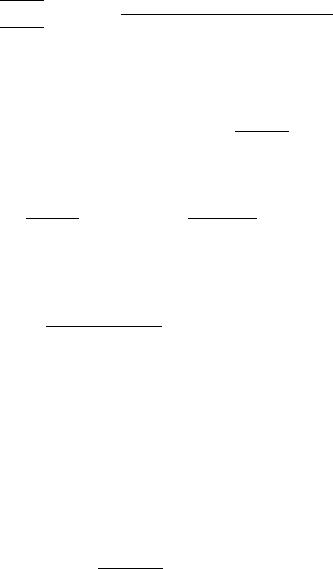
11.5 Transformation of Acoustic Impedance |
|
|
289 |
||
According to Formula 4C, |
Pb1R |
¼ |
Zc2L Z f 1 |
, the equation above can be |
|
P f 1R |
|
Zc2LþZ f 1 |
|||
rearranged as:
|
|
e |
|
|
|
|
Zc2L |
Z |
|
e |
|
|
|
|
|
Z |
|
|
|
|
Z e |
|
Z 2Z e |
|
|
|||||||||||||||||
|
|
|
jkL1 |
þ |
Zc2L Z f 1 |
|
|
jkL1 |
|
|
|
|
|
|
|
|
|
|
|
|
|
jkL1 |
|
|
|
|
|
|
|
|
|
|
|
jkL1 |
||||||||
Zc1L =Z f 1 |
|
|
|
|
|
þ f 1 |
|
|
|
=Z f 1 |
|
|
c2L þ |
|
f 1 |
|
|
jkL1 þ |
|
|
c2L |
|
|
|
f 1 |
jkL1 |
||||||||||||||||
e |
|
|
2 |
Zc2L |
|
Z f 1 |
|
|
|
|
|
|
|
|
|
|
|
|
|
|
|
|||||||||||||||||||||
|
|
|
|
Zc2L |
þZ f 1 e |
|
|
|
|
|
|
|
|
|
þ |
|
|
|
|
|
|
|
|
|
|
|
|
|
|
|
|
|
||||||||||
|
|
|
jkL1 |
|
|
|
|
|
|
|
|
jkL1 |
|
|
|
Zc2L |
|
|
Z f 1 |
|
e |
2 Zc2L 2Z f 1 |
|
e |
|
|||||||||||||||||
Divide both the numerator and denominator by ejkL1 |
þ e jkL1 |
as: |
|
|
|
|
|
|
|
|
|
|
||||||||||||||||||||||||||||||
|
Zc2L |
e |
|
þ |
e |
|
|
þ |
Z f 1 |
|
e |
|
|
e |
|
|
|
|
|
|
|
þ |
|
|
|
|
ejkL1 |
|
|
e jkL1 |
|
|||||||||||
Zc1L =Z f 1 |
jkL1 |
jkL1 |
|
|
|
|
=Z f 1 |
|
|
|
ðe 1 |
þ |
e 1 |
Þ |
||||||||||||||||||||||||||||
|
|
|
|
|
|
|
|
|
|
jkL1 |
|
|
jkL1 |
|
ejkL1 |
|
e jkL1 |
|
|
jkL |
Þ |
|||||||||||||||||||||
|
|
|
|
|
|
jkL1 |
|
|
|
|
jkL1 |
|
|
|
|
|
|
jkL1 |
|
|
|
jkL1 |
|
|
|
|
|
Zc2L |
|
|
Z f 1 |
ð |
jkL |
|
|
|||||||
|
Zc2L |
e |
|
|
e |
|
Þ þ |
Z f 1 |
ð |
e |
|
þ |
e |
|
|
Þ |
|
|
|
|
ð |
|
|
|
|
|
|
Þ |
þ Z f 1 |
|||||||||||||
|
|
|
|
ð |
|
|
|
|
|
|
|
|
|
|
|
|
|
|
|
|
|
Zc2L ðejkL1 þe jkL1 Þ |
||||||||||||||||||||
because:
|
|
|
|
|
|
|
|
|
|
|
|
|
|
||
|
|
|
|
sin ðkL1Þ |
|
ejkL1 |
e jkL1 |
|
1 |
|
e |
jkL1 |
e |
jkL1 |
|
tan |
ð |
kL1 |
Þ ¼ |
|
|
2j |
|
|
|
||||||
|
|
|
|
|
|
|
|
|
|
||||||
¼ ejkL1 |
|
¼ j |
|
|
|
|
|||||||||
|
|
cos ðkL1Þ |
þ2e jkL1 |
|
ejkL1 |
þ e jkL1 |
|||||||||
Therefore, the combined acoustic impedance Zc1L at the LHS of Pipe 1 can be
calculated from Zc2L at the LHS of Pipe 2 as: |
|
|
|
|
|||||||
Z = Z |
|
Zc2L þ jZ f 1 tan ðkL1Þ |
ð |
Formula 5 |
Þ |
||||||
|
c1L |
f 1 jZc2L tan |
ð |
kL1 |
Þ þ |
Z f 1 |
|
||||
|
|
|
|
|
|||||||
where: |
|
|
|
|
|
|
|
|
|
|
|
|
|
|
Z f 1 ¼ |
ρoc |
|
|
|
|
|||
|
|
|
S1 |
|
|
|
|
|
|||
This concludes the proof of the formula for combined acoustic impedance in the pipe.
Two Special far End Boundary Conditions Case 1: Closed End Case Pf1R = Pb1R
The relationship above between the forward wave Pf1R and backward wave Pb1R can be obtained by Formula 4C for closed end (ZcoL ¼ 1) as:
P f 1R |
¼ |
ZcoL þ Z f 1 |
ð |
Formula 4C |
Þ |
||
|
|
||||||
Pb1R |
ZcoL |
|
Z f 1 |
|
|||
|
|
||||||
Substitute ZcoL ¼ 1 into Formula 4C as:

290 |
|
|
|
|
|
|
|
11 Power Transmission in Pipelines |
||
|
P f 1R |
|
ZcoL |
Z f 1 |
|
|
Z f 1 |
|
ρoc |
|
|
|
|
|
|
1 þ S1 |
|
||||
|
|
¼ |
|
þ |
¼ |
1 |
þ |
¼ |
|
¼ 1 |
|
Pb1R |
ZcoL |
Z f 1 |
1 |
Z f 1 |
ρoc |
||||
|
|
|
|
|
|
|
|
1 S1 |
|
|
! P f 1R = Pb1R
where ZcoL ¼ 1 due to the closed far end at x ¼ 0 (special case of Zc0Lfor the closed end boundary condition).
The same relationship between the forward wave and backward wave can be obtained by the conservation of mass for the closed end boundary condition as:
|
P f 1R |
U f 1R þ Ub1R ¼ 0 |
P f 1R |
ðconservation of massÞ |
||||||
|
Pb1R |
¼ 0 |
|
|
Pb1R |
¼ 0 |
! P f 1R =Pb1R |
|||
! |
|
þ |
|
! |
|
2 |
Z f 1 |
|||
Z f 1 |
Zb1 |
Z f 1 |
||||||||
Case 2: Open End Case :Pf1R = 2 Pb1R
The relationship above between the forward wave Pf1R and backward wave Pb1R
can be obtained by Formula 4C for open end (ZcoL ¼ 0) as: |
|
|
|
||||||
|
PfR |
|
ZcoL þ Z f 1 |
|
|
Formula 4C |
|
||
PbR ¼ |
|
ð |
Þ |
||||||
ZcoL |
|
Z f 1 |
|
||||||
|
|
||||||||
Substitute ZcoL ¼ 0 into Formula 4C as:
PfR |
¼ |
ZcoL þ Z f 1 |
¼ |
0 þ Z f 1 |
¼ |
1 |
||||
|
|
|
||||||||
PbR |
ZcoL |
|
Z f 1 |
0 |
|
Z f 1 |
|
|||
|
|
|
||||||||
! P f 1R = 2Pb1R
where ZcoL ¼ 0 due to the far open end at x ¼ 0 (special case of Zc0Lfor the open end boundary condition).
The same relationship between the forward wave Pf1R and backward wave Pb1R can be obtained by balancing pressure for the open end boundary condition ( Pf0L ¼ Pb0L ¼ 0 at the outside of an open end pipe) as:
P f 1R þ Pb1R ¼ P f 0L þ Pb0L |
ðstate of equilibriumÞ |
!P f 1R þ Pb1R ¼ 0
!P f 1R = 2Pb1R
Four Combinations of the Complex Acoustic Impedances for the Special far End Conditions Stated Above and the Special Near end Conditions Below:
• General case of Zc2L: |
|
|
|
|
|
|
|
|
|
|
|
||||
Z |
|
Pc2L |
|
Pf 2L þ Pb2L |
|
Z |
|
Pf 2L þ Pb2L |
|
general case |
|
||||
c2L Uc2L |
|
|
|
ð |
Þ |
||||||||||
|
Uf 2L |
þ |
Ub2L |
|
f 2 Pf 2L |
|
Pb2L |
|
|||||||
|
|
|
|
|
|
|
|
|
|
|
|
|
|
||
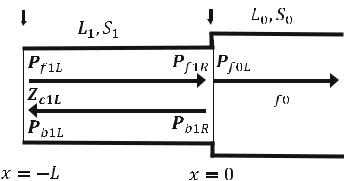
11.5 Transformation of Acoustic Impedance |
291 |
• Special case of Zc2Lfor closed end boundary condition (Uc2L ¼ 0):
Zc2L ¼ |
Pc2L |
¼ |
Pc2L |
¼ 1 |
ðclosed endÞ |
Uc2L |
0 |
• Special case of Zc2L for open end boundary condition (Pc2L ¼ 0):
Zc2L ¼ |
Pc2L |
0 |
¼ 0 |
ðopen endÞ |
|
|
¼ |
|
|||
Uc2L |
Uc2L |
||||
Consider a single pipe with a finite length L. Assume the acoustic impedance at the near end is Zc1L and the acoustic impedance at the far end is Zc2L as shown in the figure above.
The four combinations of the complex acoustic impedances Zc1L and Zc2L of a single pipe for special end conditions are shown below:
|
Near end: (x ¼ L ) |
Far end: (x ¼ 0) |
Case 1 |
CLOSED: Zc1L = 1 |
CLOSED: Zc2L = 1 |
Case 2 |
OPEN: Zc1L = 0 |
OPEN: Zc2L = 0 |
Case 3 |
OPEN: Zc1L = 0 |
CLOSED: Zc2L = 1 |
Case 4 |
CLOSED: Zc1L = 1 |
OPEN: Zc2L = 0 |
|
Pipe 1 |
|
Pipe 0 |
|
|
|
|
near end |
far end |
||
|
|
||
 =
= 
For case 1 and case 2, the detail calculations based on the combined acoustic impedance are given in Example 11.1 and 11.2. Case 3 and case 4 will be left as two exercises. Note that the results are identical to the solutions in Examples 7.1 and 7.2.

292 |
11 Power Transmission in Pipelines |
Example 11.1: (Case 1: Closed-Closed)
For Case 1: a pipe with a CLOSED near end and a CLOSED far end
Near end |
Pipe 1 |
Far end |
Pipe 0 |
||||||
|
|
|
|
|
|
|
|
|
|
|
|
|
|
= ∞ |
|
|
|
|
= ∞ |
|
|
|
|
|
|
|
|
|
|
|
|
|
|
|
|
|
|
|
|
|
|
|
|
|
|
|
|
|
|
The relationship between Zc1L of Pipe 1 and Zc0L of Pipe 0 is: |
|
||||||||
Z |
=Z |
Zc0L þ jZ f 1 tan ðkLÞ |
ð |
Formula 5 |
Þ |
||||
c1L |
|
f 1 jZc0L tan |
ð |
kL |
Þ þ |
Z f 1 |
|
||
|
|
|
|
|
|
|
|
||
The mode shapes are related to the wavenumber k that satisfies the given two boundary conditions:
Near end: CLOSED: Zc1L = 1 at x ¼ L Far end: CLOSED: Zc0L = 1 at x ¼ 0
Substituting Zc1L = 1 and Zc0L = 1 into the relationship between Zc1L of Pipe 1 and Zc0L of Pipe 0 yields:
Zc1L = Z f 1 |
Zc0L þ jZ f 1 tan ðkLÞ |
|||
jZc0L tan ðkLÞ þ Z f 1 |
||||
|
|
|||
! 1 |
=Z f 1 |
Zc0L þ 0 |
||
|
|
jZc0L tan ðkLÞ þ 0 |
||
Note that the two terms with Zf1are negligible because Zc0L is infinite. Rearranging the above equation gives:
|
2jZ f 1 |
= |
1 |
|
|
|
|
! |
jZ f 1 |
|
cos ðkLÞ |
= |
1 |
||||||||
|
|
|
|
|
|
|
|||||||||||||||
ð |
kL |
Þ |
|
|
|
|
|
|
|
|
ð |
kL |
Þ |
|
|||||||
|
tan |
|
|
|
|
|
|
|
|
|
|
sin |
|
|
|||||||
! sin ðknLÞ = 0 |
|
|
|
|
|
|
|
|
π |
|
and n ¼ 1, 2, 3, ∙ ∙ ∙ |
||||||||||
|
|
|
where kn ¼ n L , |
|
|||||||||||||||||
The resonant frequencies (ωn ¼ 2πfn ¼ ckn) are: |
|
|
|
|
|
|
|||||||||||||||
|
|
ckn |
|
|
c |
π |
|
cn |
, where n |
¼ 1, 2, 3, ∙ ∙ ∙ |
|||||||||||
|
f n ¼ |
|
|
¼ |
|
n L |
¼ |
|
|
||||||||||||
|
2π |
2π |
2L |
||||||||||||||||||
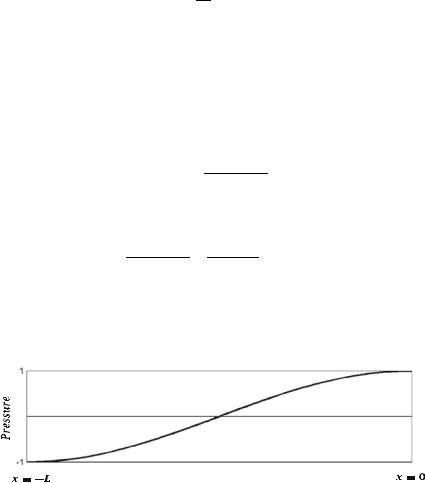
11.5 Transformation of Acoustic Impedance |
293 |
And at these resonant frequencies ωn ¼ ckn, the mode shapes of the pressure with eigenfrequencies obtained above are:
p =P f 1Re jð kxÞ þ Pb1Re jðkxÞ
=P f 1Re jð kxÞ þ P f 1Re jðkxÞ
= P f 1R e jð kxÞ þ e jðkxÞ
=2P f 1R cos ðknxÞ
¼P cos nLπ x , where n ¼ 1, 2, 3, ∙ ∙ ∙
where the complex amplitude Pb1R is equal to the complex amplitude Pf1R as:
P f 1R ¼ Pb1R
The relationship above between the forward wave Pf1R and backward wave Pb1R can be obtained by Formula 4C for closed end (ZcoL ¼ 1) as shown in Example 11.2 as:
P f 1R |
¼ |
ZcoL þ Z f 1 |
ð |
Formula 4C |
Þ |
||
|
|
||||||
Pb1R |
ZcoL |
|
Z f 1 |
|
|||
|
|
||||||
Substitute ZcoL ¼ 1 into Formula 4C as:
P f 1R |
|
ZcoL |
Z f 1 |
|
|
Z f 1 |
|
ρoc |
|
|
|
|
|
1 þ S1 |
|
||||
|
¼ |
|
þ |
¼ |
1 |
þ |
¼ |
|
¼ 1 |
Pb1R |
ZcoL |
Z f 1 |
1 |
Z f 1 |
ρoc |
||||
|
|
|
|
|
|
|
1 S1 |
|
! P f 1R = Pb1R
Hence, the first three modes of pressure in the pipe of the closed-closed ends are: Mode 1:
|
πc |
π |
π |
|
2π |
|
ω1 ¼ |
L |
; p1ðxÞ ¼ P cos L x ; k1 |
¼ L |
¼ |
|
! λ1 ¼ 2L |
λ1 |
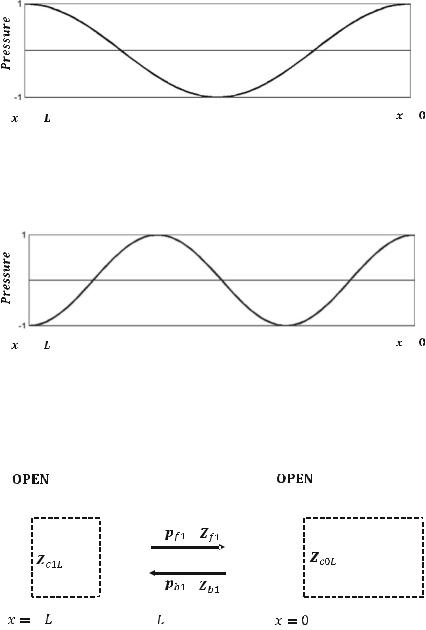
294 |
11 Power Transmission in Pipelines |
Mode 2:
= − |
|
|
|
|
|
|
|
|
= |
|
2πc |
2π |
|
|
2π |
|
2π |
|
|
ω2 ¼ |
|
; p2ðxÞ ¼ P cos |
|
x ; k2 |
¼ |
|
¼ |
|
! λ2 ¼ L |
L |
L |
L |
λ2 |
||||||
Mode 3:
= − |
|
|
|
|
|
|
|
|
= |
||
|
πc |
|
3π |
|
|
3π |
|
2π |
|
2 |
|
ω3 ¼ |
3 |
; p3ðxÞ ¼ P cos |
|
x ; k3 |
¼ |
|
¼ |
|
! λ3 ¼ |
|
L |
L |
L |
L |
λ3 |
3 |
|||||||
Example 11.2 (Case 2: Open-Open)
For Case 2: a pipe with an OPEN near end and an OPEN far end
Near end |
Pipe 1 |
Far end |
Pipe 0 |
||||
|
|
|
|
|
|
|
|
= 0 |
|
|
|
= 0 |
|||
|
|
|
|
|
|
|
|
|
|
|
|
|
|
|
|

11.5 Transformation of Acoustic Impedance |
295 |
The relationship between Zc1L of Pipe 1 and Zc0L of Pipe 0 is: |
|
|
|
||||||
Z |
=Z |
Zc0L þ jZ f 1 tan ðkLÞ |
ð |
Formula 5 |
Þ |
||||
c1L |
|
f 1 jZc0L tan |
ð |
kL |
Þ þ |
Z f 1 |
|
||
|
|
|
|
|
|
|
|
||
The mode shapes are related to the wavenumber k that satisfies the given two boundary conditions:
Near end: OPEN: Zc1L = 0 at x ¼ L Far end: OPEN: Zc0L = 0 at x ¼ 0
Substituting Zc1L = 0 and Zc0L = 0 into the relationship between Zc1L of Pipe 1 and Zc0L of Pipe 0 yields:
Zc1L = Z f 1 |
Zc0L þ jZ f 1 tan ðkLÞ |
|||||
jZc0L tan ðkLÞ þ Z f 1 |
||||||
|
|
|
||||
! |
0 = Z |
f 1 |
0 þ jZ f 1 tan ðkLÞ |
|||
|
0 |
þ |
Z f 1 |
|||
|
|
|
|
|
||
! jZ f 1 tan ðkLÞ =0
The eigenfrequencies that satisfy the above equation are:
sin ðknLÞ =0 where kn ¼ n Lπ and n ¼ 1, 2, 3, ∙ ∙ ∙
The resonant frequencies (ωn ¼ 2πfn ¼ ckn) are:
f n ¼ ck2πn ¼ 2cπ n Lπ ¼ 2cnL , where n ¼ 1, 2, 3, ∙ ∙ ∙
And at these resonant frequencies ωn ¼ ckn, the mode shapes of the pressure with eigenfrequencies obtained above are:
p = P f 1Re jð kxÞ þ Pb1Re jðkxÞ
= P f 1Re jð kxÞ P f 1Re jðkxÞ
= P f 1R e jð kxÞ e jðkxÞ
= 2jP f 1R sin nLπ x , where n ¼ 1, 2, 3,
where the complex amplitude Pb1R is equal to the complex amplitude Pf1R as:
P f 1R ¼ 2Pb1R
The relationship above between the forward wave Pf1R and backward wave Pb1R can be obtained by Formula 4C for open end (ZcoL ¼ 0, based on Formula 4C) as:
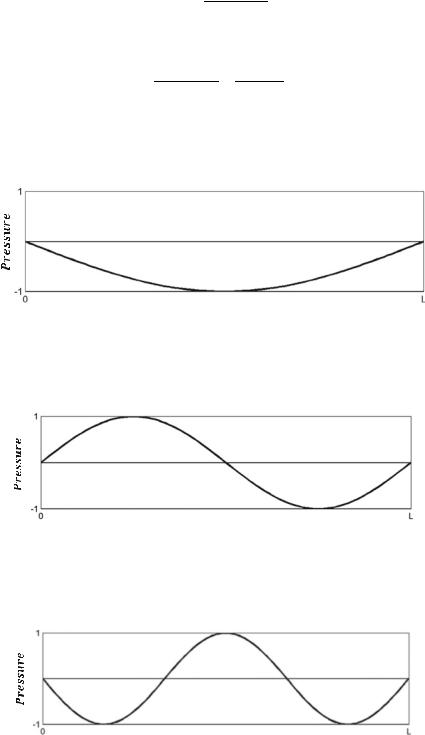
296 11 Power Transmission in Pipelines
P f 1R |
¼ |
ZcoL þ Z f 1 |
ð |
Formula 4C |
Þ |
||
|
|
||||||
Pb1R |
ZcoL |
|
Z f 1 |
|
|||
|
|
||||||
Substitute ZcoL ¼ 0 into Formula 4C as:
P f 1R |
¼ |
ZcoL þ Z f 1 |
¼ |
0 þ Z f 1 |
¼ |
1 |
||||
|
|
|
||||||||
Pb1R |
ZcoL |
|
Z f 1 |
0 |
|
Z f 1 |
|
|||
|
|
|
||||||||
! P f 1R = 2Pb1R
Hence, the first three modes of the pipe for the open-open ends are: Mode 1:
|
πc |
π |
π |
|
2π |
|
ω1 ¼ |
L |
; p1ðxÞ ¼ P sin L x ; k1 |
¼ L |
¼ |
|
! λ1 ¼ 2L |
λ1 |
Mode 2:
ω2 ¼ |
2πc |
; p2ðxÞ ¼ P sin |
2π |
x ; k2 ¼ |
2π |
¼ |
2π |
! λ2 ¼ L |
|
L |
L |
L |
|
λ2 |
|||||
Mode 3:
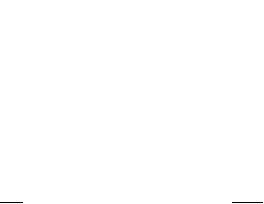
11.6 Power Reflection and Transmission |
297 |
ω3 ¼ |
3πc |
; p3ðxÞ ¼ P sin |
3π |
x ; k3 ¼ |
3π |
¼ |
2π |
! λ3 ¼ |
2 |
L |
L |
L |
L |
λ3 |
3 |
11.6Power Reflection and Transmission
11.6.1 Definition of Power of Acoustic Waves
The power of an acoustic wave is calculated from the pressure and velocity as the following:
(POWER) worktime ¼(PRESSURE) forcearea (VELOCITY) distanceime (AREA) [area]
Note that the work in the above equation is the force multiplied by the distance (work ¼ force distance):
Based on the above definition of power, the power of the acoustic wave is:
w ¼ Re ðPÞ Re ðVÞS ¼ Re ðPÞ Re ðUÞ
Re P Re Z |
|
4 |
|
P P |
Z |
|
Z |
|||
|
|
P |
|
1 |
|
|
P |
|
P |
|
¼ ð Þ |
|
|
¼ |
|
ð |
þ Þ |
|
þ |
|
|
11.6.2Power Reflection and Transmission Coefficients of One-to-One Pipes
Formulas 6A–6B |
|
|
|
|
|
|
|
|
|
|
|
|
|
|
The power reflection and |
|
transmission |
coefficients |
in one-to-one |
pipes are |
|||||||||
defined as: |
|
|
|
|
|
|
|
|
|
|
|
|
|
|
|
|
|
|
|
|
|
|
Pr |
|
|
|
|
||
Rw |
|
|
wr |
|
|
Re ðPrÞ Re Zr |
|
|
Formula 6A |
Þ |
||||
|
|
i |
|
|
|
|||||||||
|
|
w |
¼ Re ðPiÞ Re |
Zi |
ð |
|
|
|||||||
|
|
|
|
|
|
|
Pi |
|
|
|
|
|||
|
|
|
|
|
|
|
|
Po |
|
|
|
|
||
Tw |
|
wo |
|
|
Re ðPoÞ Re Zo |
|
|
Formula 6B |
|
|||||
|
|
w |
i |
¼ |
|
ð |
Þ |
|||||||
|
|
|
Re ðPiÞ Re |
Zi |
|
|
||||||||
|
|
|
|
|
|
|
Pi |
|
|
|
|
|||
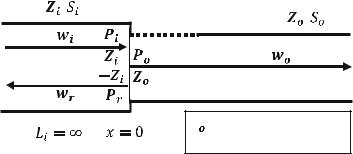
298 |
11 Power Transmission in Pipelines |
,
,
 , in general, can be a real or complex number
, in general, can be a real or complex number
11.6.3Simplified Cases of Power Reflection and Transmission in One-to-One Pipes
Based on the definition of power transmission:
Tw |
|
wo |
|
Re ðPoÞ Re |
Zo |
|
|
|
|
|
|
|
Po |
|
|
|
|
¼ |
|
|
|
w |
i |
Re ðPiÞ Re |
Zi |
||
|
|
|
|
|
Pi |
|
The following two simplified formulas can be derived for the relevant conditions: If Zi and Zo are real:
|
½ Re ðPoÞ&2 |
Zi |
Then, Tw ¼ |
½ Re ðPiÞ&2 |
Zo. |
If Zi, Zo and Pi are real:
Then, Tw ¼ h Re Poi2 Zi .
Pi Zo
11.6.4Special Case of Power Reflection and Transmission: One-to-One Pipes
Formulas 7A–7E
Power of Traveling Plane Waves
Power reflection and transmission in one-to-one pipes can be formulated with real acoustic impedance Z and real magnitude P as:
2 |
1 |
ðFormula 7AÞ |
wi ¼ Pi |
|
|
Zi |
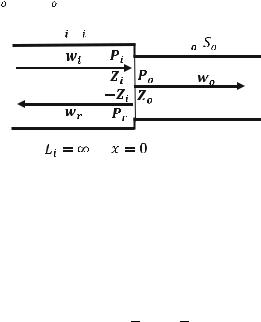
11.6 Power Reflection and Transmission |
|
|
|
|
|
|
|
|
|
|
|
299 |
|||||||
|
|
|
|
|
|
|
|
2 |
|
|
1 |
|
|
|
|
|
|
ðFormula 7BÞ |
|
|
|
|
|
|
|
|
wr ¼ Pr |
|
|
|
|
|
|||||||
|
|
|
|
|
|
Zi |
|
|
|||||||||||
Rw ¼ wi |
|
|
|
2 |
¼ Zo |
Zi |
2 |
ðFormula 7CÞ |
|||||||||||
¼ Pi |
|
|
|||||||||||||||||
|
wr |
|
|
|
Pr |
|
|
Zo |
|
|
Zi |
|
|
|
|||||
|
|
|
|
|
|
|
|
|
|
|
|
|
þ |
|
|
|
|||
|
wo |
|
Po |
2 Zi |
|
|
2Zo |
|
|
|
2 Zi |
|
|||||||
Tw ¼ |
|
¼ |
|
|
|
|
¼ |
|
|
|
|
|
|
|
ðFormula 7DÞ |
||||
wi |
Pi |
|
Zo |
Zo |
þ |
Zi |
Zo |
||||||||||||
|
|
|
|
|
|
|
|
|
|
|
|
|
|
|
|
|
|
||
|
|
|
|
|
|
|
wi þ wr ¼ wo |
|
|
ðFormula 7EÞ |
|||||||||
where, for traveling plane waves, the following quantities are real numbers:
Zi, Zo, Pi, Po real
 ,
,  ,
,  ,
,  real
real
 ,
,
 ,
,
Proof of Formulas 7A and 7B
For traveling plane waves (forward and backward) in pipes:
•The acoustic impedance Z is a real number.
•The complex amplitude of pressure P is also a real number.
Therefore, Formula 7A for the power of acoustic waves can be formulated with real acoustic impedance Z and real magnitude P as:
w ¼ Re ðPÞ Re P ¼ P2 1
Z Z
Because Zr ¼ Zi (Formula 1B), when the power is formulated with Zi, the power carried by the forward wave Pi and backward wave Pr are formulated as:
|
|
2 |
1 |
|
|
wi ¼ Pi |
|
|
|
||
Zi |
|
||||
2 |
1 |
|
2 |
1 |
|
wr ¼ Pr |
|
¼ Pr |
|
||
Zr |
Zi |
||||
300 11 Power Transmission in Pipelines
Proof of Formulas 7C and 7D
The power reflection and transmission coefficients are defined as:
Rw |
|
wr |
|
|
Re ðPrÞ Re |
Zr |
|
|
|
|
|
|
|
|
Pr |
|
|
|
|
¼ |
|
|
|
|
w |
i |
Re ðPiÞ Re |
Zi |
|||
|
|
|
|
|
|
Pr |
|
Tw |
|
wo |
|
|
Re ðPoÞ Re |
Zo |
|
|
|
|
|
|
|
|
Po |
|
|
|
|
¼ |
|
|
|
|
w |
i |
|
Re ðPiÞ Re |
Zi |
||
|
|
|
|
|
|
Pr |
|
Because the following quantities for traveling plane waves in one-to-one pipes are real numbers:
Zi, Zr, Zo, Pi, Po real numbers
and:
Zr ¼ Zi |
ðFormula 2BÞ |
Therefore, the power reflection and transmission coefficients can be simplified as:
|
|
|
|
|
|
|
|
|
|
Pr |
|
|
|
P2 |
|
|
|
|
|
|
|
|||
|
|
|
|
|
|
|
Re ðPrÞ Re Zr |
|
|
|
r |
|
|
|
Pr |
2 |
||||||||
R |
w |
|
|
|
|
|
|
Zr |
|
|
||||||||||||||
|
|
|
|
|
|
|
|
Pr |
|
|
|
Pi2 |
|
Pi |
|
|
||||||||
|
|
|
|
¼ |
|
Re ðPiÞ Re Zi |
|
¼ |
|
|
|
|
¼ |
|
|
|
|
|||||||
|
|
|
|
|
|
|
Zi |
|
|
|
||||||||||||||
|
|
|
|
|
|
|
|
|
Po |
|
|
P2 |
|
|
|
|
|
|
|
|||||
|
|
|
|
|
|
Re ðPoÞ Re Zo |
|
|
|
|
o |
|
|
Po |
2 Zi |
|||||||||
T |
w |
¼ |
|
¼ |
Zo |
|
|
¼ |
||||||||||||||||
|
|
|
|
|
Pr |
|
Pi2 |
|
Pi |
|
|
Zo |
||||||||||||
|
|
|
|
Re ðPiÞ Re Zi |
|
|
|
|
|
|
|
|||||||||||||
|
|
|
|
Zi |
|
|
|
|
|
|
|
|||||||||||||
Based on Formulas 4C–4D: |
|
|
|
|
|
|
|
|
|
|
|
|
|
|
|
|
||||||||
|
|
|
|
|
|
|
|
Pb1L |
|
ZfoL Z f 1 |
|
|
|
|
|
|
||||||||
|
|
|
|
|
|
|
|
P f 1R |
¼ ZfoL |
þ |
Z f 1 |
|
|
|
|
|
|
|||||||
|
|
|
|
|
|
|
|
|
|
|
|
|
|
|
|
|||||||||
|
|
|
|
|
|
|
|
PfoL |
|
|
2ZfoL |
|
|
|
|
|
|
|
||||||
|
|
|
|
|
|
|
|
P f 1R |
¼ ZfoL |
þ |
Z f 1 |
|
|
|
|
|
|
|||||||
|
|
|
|
|
|
|
|
|
|
|
|
|
|
|
|
|||||||||
ðFormula 4CÞ
ðFormula 4DÞ
The power reflection and transmission coefficients can be formulated as:
Rw ¼ wi |
|
|
|
2 |
¼ Zo |
Zi |
2 |
ðFormula 7CÞ |
||||||||||
¼ Pi |
|
|
||||||||||||||||
|
wr |
|
|
|
Pr |
|
|
|
Zo |
|
Zi |
|
|
|
||||
|
|
|
|
|
|
|
|
|
|
|
|
|
þ |
|
|
|
||
|
wo |
|
Po |
2 Zi |
|
|
|
2Zo |
|
|
2 Zi |
|
||||||
Tw ¼ |
|
¼ |
|
|
|
|
¼ |
|
|
|
|
|
|
|
|
ðFormula 7DÞ |
||
wi |
Pi |
|
Zo |
Zo |
þ |
Zi |
Zo |
|||||||||||
|
|
|
|
|
|
|
|
|
|
|
|
|
|
|
|
|
||
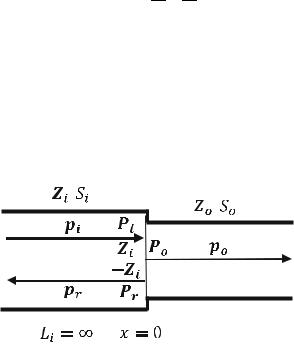
11.6 Power Reflection and Transmission |
301 |
Proof of Formula 7E
Based on the law of conservation of energy, the power that goes into a system has to equal the power that comes out of it:
(POWER IN) ¼ (POWER OUT)
Therefore, the summation of power on the left-hand side pipe equals the summation of power on the right-hand side pipe:
wi þ wr ¼ wo |
ðFormula 7EÞ |
Divide the equation above by wi to obtain the power ratio:
1 þ wr ¼ wo wi wi
!1 þ Rw ¼ Tw
!Rw þ Tw ¼ 1
Note that wi and wo does positive work but wr does negative work due to the negative impedance (180 phase difference between the pressure and the velocity).
Example 11.3: Power Transmission Coefficient
The cross-section area of Pipe i and Pipe o as shown below are Si ¼ 0.0830 [m2] and So ¼ 0.0415 [m2], respectively:
,
,
Use 415 rayls for the characteristic impedance (ρoc) of air.
(a)Determine the power reflection coefficient Rw.
(b)Determine the power transmission coefficient Tw.
(c)Validate your answers in parts a and b using the conservation of energy.
Solution of Example 11.3
The acoustic impedances in Pipe i and Pipe o can be calculated based on Formulas 1A and 1B as:

302 |
|
|
|
|
|
|
|
|
|
|
|
|
|
11 Power Transmission in Pipelines |
|||
|
|
|
Zi ¼ |
ρoc |
415 |
¼ 50 |
ðFormula 1AÞ |
||||||||||
|
|
|
|
|
¼ |
|
|
||||||||||
|
|
|
Si |
0:083 |
|||||||||||||
Zr |
¼ |
ρoc |
¼ |
415 |
|
¼ |
50 |
ð |
Formula 1B |
Þ |
|||||||
|
|
Si |
|
0:083 |
|
|
|
|
|||||||||
Zo ¼ |
ρoc |
¼ |
|
415 |
|
¼ 100 |
|
ðFormula 1AÞ |
|||||||||
|
So |
0:0415 |
|
|
|||||||||||||
Note that Zi, Zr, and Zo are real numbers.
(a) The power reflection coefficients can be calculated based on Formula 7C as:
|
¼ Zo |
Zi |
2 |
¼ 100 |
|
50 |
2 |
¼ 9 |
ð |
|
Þ |
|
Rw |
|
Zo |
Zi |
100 |
|
50 |
1 |
|
Formula 7C |
|
||
|
|
þ |
|
|
þ |
|
|
|
|
|||
|
|
|
|
|
|
|
|
|
|
|
||
(b) The power transmission coefficients can be calculated based on Formula 7D as:
|
¼ |
Zo þ Zi |
2 |
Zo |
¼ |
100 þ 50 |
2 |
100 |
¼ 9 |
ð |
|
Þ |
|
Tw |
|
|
2Zo |
Zi |
|
2 100 |
50 |
8 |
|
Formula 7D |
|
||
|
|
|
|
|
|
|
|
|
|
|
|||
(c) Based on the conservation of energy (Formula 7E):
wi þ wr ¼ wo
Divide the equation above by wi to obtain the power ratio:
1 þ wr ¼ wo wi wi
!1 þ Rw ¼ Tw
Substituting the power reflection (Rw ¼ 91 ) and power transmission (Tw ¼ 89 ) calculated in Parts a and b into the conservation of energy (1 + Rw ¼ Tw) gives:
1 þ Rw ¼ Tw
! 1 19 ¼ 89
The equation above validates the power reflection (Rw) and power transmission (Tw) calculated in Parts a and b.
